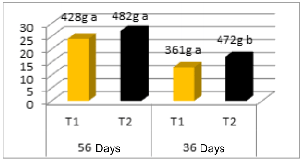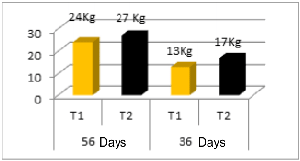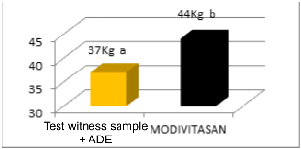Clinical Trial
Evaluation of an Organic Modifier (Modivitasan®)
Evaluation of an Organic Modifier (Modivitasan®) on Weight Gain of Pasturing Calves in Tropical Rainforest of Mexico.
Autores: Dr. Fernando Livas Calderón, Mc. Albino Mateos Romo.
INTRODUCTION
Tropical rainforest of Mexico represent 26% of the national territory, and its importance is based on the potential use of fodder produced in natural form, which is liable of being used in dual purpose cattle raising. However, due to different climatic and zootechnical factors, productivity and reproductive efficiency are still confined to limited levels (Galvez, 2013). In these areas, the growth of pasturing calves depends on two main factors: the consumption of breast milk, and the availability of fodder with adequate nutritional quality, represented by the presence of protein, energy and minerals. That is why, calves weaned between 8 and 9 months of age have a weight ranging from 150 to 180 kg, affecting the economy of the cattle breeder who receives insufficient payment for each calf being commercialized.
In light of this situation, breeders are looking for maximization of cattle yield, which implies an increase in nutritional requirements in order to obtain better productive parameters. It must also be considered that the contribution of the primary factors, like energy and protein, is ineffective if their interaction with minerals and vitamins is not taken on account, as essential nutrients in animal feed (Repetto et al., 2004).
In this sense, the use of organic modifiers based on amino acids, vitamins, minerals and ATP, becomes a good alternative for the increase of production and improvement of feed efficiency of animals. Consequently, these products affect positively the intestinal absorption of nutrients with corresponding growth of the animal (Rios et al., 2013), as well as the metabolic functions of the animal, which increases its production of proteins (Vargas, 2005). Similarly, organic modifiers produce an increase of muscle growth and a decrease of fat disposal, through the increase of nitrogen retention in muscles (Vargas, 2005).
Energy is another important nutrition requirement for development of animals. It is well known that meat cattle uses more than half of its metabolizable energy in the process of degradation of protein to amino acids, leaving too little energy available for growth and development of young animals (Livas, 2013).
The main factor responsible of proportioning metabolizable energy to the organism is adenosine triphosphate (ATP), which participates in all energetic transactions of the body. This molecule is a nucleotide which is essential for the cell and a source of energy for most of cell functions (Bondi, 1989). That is why when administered by parenteral route, it provides the animal with a source of energy that can be used immediately for its growth and development.
In view of the above mentioned needs, the organic modifier MODIVITASAN®3 was developed based on 10 minerals, 9 amino acids, 4 vitamins and one source of direct energy by means of ATP. This association supplies to the cattle with all necessary to optimize increase in weight gain, stimulating organic functions with a revitalizing and reconstituent effect. The use of ATP is very important as source of energy during the formative process of muscular tissue.
OBJECTIVE OF THE STUDY
To evaluate the effect of an organic modifier (MODIVITASAN®) on the weight gain of pasturing calves in tropical rainforest of Mexico.
LOCATION OF THE STUDY AREA
This evaluation was performed at Victoria ranch, located at Km 30 of transistmic highway in the Municipality of Sayula de Aleman, in the city of Veracruz, Mexico. The characteristic of this area is its warm humid weather (tropical rainforest), with an annual mean temperature of 26.7 ºC and an annual rain precipitation of 1839 mm. The month with heaviest rain is September with 314.3 mm., while the lowest rain is in March with 49 mm.
DATE AND DURATION OF STUDY
The present study had length of 92 days and was performed between the months of September and December 2013.
MATERIAL AND METHODS
A total of 50 calves of crossed breed (zebu and European) with approximate age between 15 and 20 months, and an average weight of 295 kg were used for the execution of this evaluation. Before the beginning of the study, all animals were identified with a plastic earring and were weighed individually using a mechanical scale, to obtain the initial weight. Animals were then ordered according to weight from lower to higher following an “S” shaped scheme in order to form both groups, so that there was no significant difference at the beginning of the study. Finally, animals were separated into two treatment groups, each one with 25 calves, as indicated as follows:
- TREATMENT 1 (T1): animals treated with injectable vitamin ADE4 at the beginning of the study and 56 days later, with a dose of 5 mL/calf by intramuscular route.
- TREATMENT 2 (T2): animals treated with an injectable organic modifier (MODIVITASAN®) at the beginning of the study and 56 days later, with a dose of 1 mL/50 kg of body weight by intramuscular route. MODIVITASAN® contains per mL: DL–Methionine 2.1 mg, L-Arginine 2.0 mg, L-Histidine 2.1mg, L- Leucine 2.1mg, L-Lysine 10.0 mg, L- Threonine 1.0 mg, L-Tryptophan 0.5 mg, L-Valine 2.0 mg, ATP 3.0 mg, Vit. A palmitate 30 000 UI, Vit. B12 0.05 mg, Vit. D3 10 000 UI, Vit. E 10 mg, Iron ammonium citrate 4.0 mg, Sodium chloride 0.42 mg, Sodium glycerophosphate 10.0 mg, Calcium gluconate 0.038 mg, Cobalt gluconate 0.201 mg, Magnesium gluconate 4.1 mg, Manganese gluconate 3.187 mg, Zinc gluconate 1.672 mg, Sodium gluconate 4.2 mg, Sodium selenite 0.5 mg, Potassium iodide 2.0 mg.
As part of the routine handling performed in the ranch, on the day of application of the treatments all animals were administered with an endectocide antiparasitic (Bovimec LA®), based on ivermectin 1% at a dose of 1 mL/50 kg of weight by intramuscular route. They also received an implant containing 40 mg of trembolone acetate and 8 mg of estradiol benzoate in the medium third of the rear side of the ear. Likewise, calves were immunized with two bacterins, as described below:
- Clostridial Complex (7 strains) at doses of 5 mL per animal by intramuscular route.
- Bacterin toxoid against Pasteurella and Haemophilus at doses of 2 mL per animal by intramuscular route.
After the application of treatments, animal were observed daily and weighed in the mechanical scale at 56 and 92 days after beginning the study.
All calves were managed under extensive breed system, forming one only pasturing group. Animals were taken to pasture in meadows covered with fodder grass African Star (C. plectostachyus), having an initial animal load of 1.18 UA/ha, a final animal load of 2.66 UA/ha, and an average animal load of 1.92 UA/ha.
The parameters to be evaluated in the study were initial and final weights, daily weight gain and accumulated weight per animal in both treatment groups.
STATISTICAL ANALYSIS
Average initial and final weights, daily weight gain and accumulated weight per animal in both treatment groups were compared with Fisher’s Significant Minimum Difference test (SMD), at a significance level of P<0.05. This procedure is an extension of Student’s t test for the case of comparison of two averages with adjusted variance.
RESULTS AND DISCUSSION
Averages of initial (PI) and final (PF) weights of calves, obtained for each group along the study can be observed in Graph 1.
Graph 1. Initial and final weights of calves with and without Modivitasan® in tropical rainforest of Mexico.
It can be observed that at the beginning of the study the averages of PI for both evaluated groups were similar, showing an average weight of 293 kg for Treatment 1 (T1) and 297 kg for Treatment 2 (T2). It can also be observed that 92 days after treatment, the averages PF were 330 kg for T1 and 341 kg for T2, showing a difference in weight gain between PI and PF of 37 kg for T1 versus 44 kg obtained for T2. When calculating the statistical test SMD, it was found that there is a statistically significant difference (P<0.05) in favor of animals of lot T2, which received the organic modifier MODIVITASAN®.
In the test performed by Delgado et al. in the Peruvian tropical rainforest, using an organic modifier (MODIVITASAN®), a difference in weight gain in the control group of 13.3 kg was obtained, versus the result obtained in this study which was 7 kg. This is probably due to the fact that in the mentioned study three applications of organic modifier were made, in comparison with two applications made in this study. Similarly, it must be kept in mind that all calves of treatment T1 received also a treatment with anabolic implant plus vitamin ADE to improve their performance.
In the present study, only two applications of treatments were considered, in order to avoid an excessive handling of animals and the physiological consequences of working the cattle too frequently. It must be borne in mind that procedures such as movement restriction in a compression sleeve generally do not cause pain, but fear can produce great psychological stress to cattle raised under extensive methods (Grandin, 1997). Additionally, stress produces growth delay, modification of gastrointestinal motility, and susceptibility to infectious agents, among other affections that produce loss of weight (Costa, 2005)
In Graph 2, the averages of daily weight gain (DWG) produced in both evaluated groups on days 56 and 92 after initial treatment, can be observed.

Graph 2. Daily weight gain in calves with and without Modivitasan® in tropical rainforest of Mexico.
On first 56 days of the study, DWG for T1 and T2 gave an average of 428 g and 482 g per day, respectively. In spite of existing a difference of 54 g in daily weight gain between both groups, this does not represent a statistically significant difference (P>0.05) between both of them. However, average DWG in following 36 test days registered 361 g per day for T1 and 472 g per day for T2, obtaining a difference of 111 g between both groups, value which is statistically different (P<0.05) in favor of T2.
These differences in DWG observed between the groups, illustrated in Graph 2, are probably due to the fact that when making the second application of the products, Group T2 received the organic modifier (MODIVITASAN®) based on amino acids, vitamins and minerals. This association stimulates the metabolism of important glands, such as pituitary, thyroid and parathyroid glands, which participate in growth and development of animals. Young calves show physiologic and metabolic synchrony of their organism, which allows for higher meat production per hectare in the same period. This synchronization is being object of more and more investigation, and greater attention is being paid to the combined function of amino acids, vitamins and minerals, which so far were only considered dietetic supplements (Veludo et al., 2002).
Average accumulated weights (PA) obtained for each group along the study, can be observed in Graphs 3 and 4.

Graph 3. Accumulated weight per calf with and without Modivitasan® in the tropical rainforest of Mexico.

Graph 4. Accumulated weight per animal during 92 days in calves with and without Modivitasan® in the tropical rainforest of Mexico.
Average PA of calves 56 days after beginning the treatment, was of 24 kg in Group T1 and 27 kg in Group T2, obtaining a difference in weight of 3 kg higher in animals treated with organic modifier (MODIVITASAN®). Similarly, it can be observed that starting on day 56 until the end of the study (36 more days), group T1 obtained an average PA of 13 kg, per calf, with a difference of PA between groups of 4 kg.
At the end of 92 days of the study, an average PA of 37 kg was obtained in Group T1, and 44 kg in Group T2. These values determine a statistically significant difference among them (P<0.05), obtaining Group T2 an amount of 7 kg more per calf in comparison with Group T1. The difference obtained between averages PA of both groups may be due to the interaction between the components of amino acids, vitamins and minerals, which can be capable of affecting the intestinal absorption of nutrients during ingestion (Rios et al., 2013), as well as stimulate the metabolism of glands that participate in growth and development of animals (Veludo et al., 2002).
CONCLUSIONS
It can be concluded that the use of an organic modifier (MODIVITASAN®) as nutritional supplement, when applied in two doses at an interval of 56 days, can affect significantly the weight gain of calves raised in the tropical rainforest of Mexico and maintained on natural pasture.
Similarly, when making a cost-benefit estimation of the application of the organic modifier (MODIVITASAN®) in calves, it can be observed an increase of income at the sale of the animal. That is why, bearing in mind the results obtained from 7 kg of live weight earned per animal, and considering that the cost of 1 kg of live calf is approximately $32.00, an extra profit of $224.00 per calf can be obtained after 92 days of breeding.
REFERENCES
- Bondi, A. 1989. Nutrición Animal (Animal Nutrition). 1st. Edition, Editorial Acribia. Zaragoza, España. 545 p.
- Cancho, B.; García, M.; Simal, J. 2000. El uso de los antibióticos en la alimentación animal: perspectiva actual. (Use of antibiotics in animal feed: Present view) Cienc. Tecnol. Aliment. Vol. 3, No. 1. España. 39-47 p.
- Cardona, I.; Sanclemente, L. 1986. Acción del undecilenato de boldenona (equipoise) más un implante de estradiol progesterona (Ganamax-m) en la ceba de novillos cebú comercial (Effect of boldenone undecylenate (Equipoise) plus an implant of progesterone estradiol (Ganamax-m) in fattening commercial zebu young bulls). Thesis Universidad Nacional de Colombia Sede Palmira. Colombia.
- Costa, E. F. 2005. El manejo del estrés y la salud en los sistemas intensivos (Stress and health management in intensive systems). XVIª Jornadas Ganaderas de Pergamino y Expofeedlot, Estudio Ganadero Pergamino. Argentina.
- Daniel WW. 1984. Bioestadística, base para el análisis de las ciencias de la salud (Biostatistics, base for analysis of health sciences). 1st. edition, Editorial Limusa, México, D.F.
- Delgado, A.; Trigueros, A.; Tang, J.; Angelats, R.; Gavidia, C.2012. Efecto de un modificador orgánico en la ganancia de peso en vacunos cebú en el trópico peruano (Effect of an organic modifier in weight gain of zebu cattle in the Peruvian tropics). Revista de Investigación Veterinaria. Vol. 23, Nº 2. Perú. 153-159 p.
- Devlin, T.M. 2004. Bioquímica Avanzada (Advanced Biochemistry). 4th. Edition. Editorial Reverté, Barcelona, España. ISBN 84-291-7208-4.
- Espinoza E. 2004. Efecto comparativo del fósforo asociado a vitaminas (Hematofos B12, complejo B) en el incremento de peso de ganado vacuno mejorado en Iquitos (Comparative effect of phosphorus associated to vitamins (Hematofos B12, complex B) in weight increase of improved cattle, in Iquitos). Tesis de Ingeniero Agrónomo. Iquitos: Universidad Nacional de la Amazonía Peruana. 85 p.
- Gálvez, A. 2013. Manual de crianza de becerros en el trópico (Manual for calves raising in the tropics). Publicación Ganadería.Mx Pecuarios. México.
- García E. 1985. Modificaciones al sistema de Clasificación Climática de Köppen para adaptarlo a las condiciones de la República Mexicana (Modifications to Köppen’s climatic classification system for adjustment to the conditions of the Mexican Republic). 4th. Edition, Instituto de Geografía.
- Grandin, T. 1997. Evaluación del estrés durante el manejo y transporte (Evaluation of stress generated during handling and transportation). Journal of Animal Science. Vol.75. Colorado, USA. 249-257 p.
- Livas, C.F. 2013. Comparación de 2 niveles de un sustrato gluconeogénico (1, 2 propanodiol) sobre las ganancias de peso y rendimiento en canal en toretes Suizo x Cebú en estabulación (Comparison of levels of a gluconeogenic substrate (1,2 propanediol) on weight gain and carcass yield of Swiss x Zebu young beef bulls in stabling). XXXVII Congreso Nacional de Buiatría. Acapulco, Gro.
- Peruchena CO, 1997. Dietas para la nutrición de bovinos en crecimiento y engorde en el sub trópico (Diet for raising and fattening cattle in sub tropics). Publicación Técnica Nº13. Argentina: INTA Corrientes. 24 p.
- Repetto J, Donovan A, García F. 2004. Carencias minerales, limitantes de la producción (Mineral shortages that restrict production). Sitio Argentino de Producción Animal (Internet), (05 mayo 2011). Available at http://wwww.produccion – animal.com.ar/suplementacion_mineral/18- arencias_limitantes_produccion.pdf.
- Ríos, E.E.; Maldonado, P.; Bogado, E.F.; Chileski,G. 2013. Ganancia de peso en novillos tratados con un compuesto inyectable de minerales, vitaminas y proteínas (Weight gain of young bulls treated with an injectable compound of minerals, vitamins and proteins). Rev. vet. Vol. 24 Nº 1. Argentina. 56-59 p.
- Vargas, T. 2005. Evaluación del uso de dos modificadores orgánicos en la ganancia de peso de mautas mestizas de doble propósito en el municipio de Machiques del estado Zulia (Evaluation of the use of two organic modifiers for weight gain of double purpose mixed breed mautas in the municipality of Machiques, Zulia State). Special work for Degree of Animal Production Engineering, Universidad Rafael Urdaneta. Maracaibo, Venezuela. 56 p.
- Veludo, R.; Lacerda, C.; Aragão de Lima, M.; Otto, M. 2002. Teste comparativo de ganho de peso em novilhos utilizando diferentes tipos de suplementos vitamínicos injetáveis (Comparative test of weight gain of young bulls using different types of injectable vitamin supplements). Ciên. Agr. Saúde. FEA. Vol. 2, Nº1. Andradina, Brasil. 18 – 20 p.


